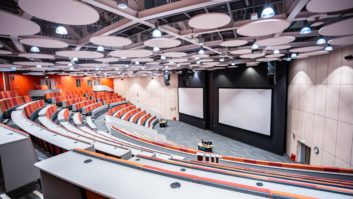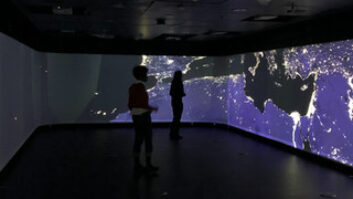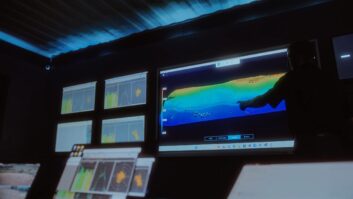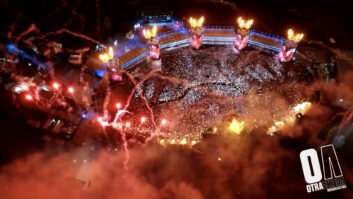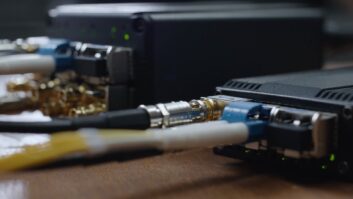Progressive Electronics installs Vaddio cameras in large-scale project at Kansas State University Olathe International Animal Health and Food Safety Institute. All spaces are designed for videoconferencing and broadcasting of presentations, lectures and labs.
Economic development officials say the US Animal Health Corridor, which stretches between Columbia, Montana and Manhattan, Kansas, accounts for 32 percent of the $19 billion global animal health industry. No wonder Johnson County residents voted to tax themselves and create the “Research Triangle Initiative” to help drive the state of Kansas into the top 5 bioscience hubs in the country.
The Johnson County Education and Research Triangle Initiative is a cooperative partnership among Johnson County, the University of Kansas and Kansas State University.
The newest member of the Research Triangle is the K-State Olathe Innovation Campus (KOIC).@page_break@
Pic: Classroom at K-State Olathe Innovation Campus
Animal Health and Food Safety Institute
The building is the first and southernmost of several buildings planned for the new 38-acre campus. The campus is part of the 92-acre Kansas Bioscience Park – home to the $581 million Kansas Bioscience Authority headquarters.
Graduate students in the biosciences and biotechnology working on masters and doctoral degrees in animal health, food safety, security and related areas will work alongside scientists involved in the latest research. The research will focus on improving animal health, making foods safer for consumers, and ensuring a secure global food supply.
Programs will also help train workers. People in private businesses will be able to get advanced degrees – collaborating with teachers and students in creating or improving products. K-State Olathe will also partner with the Kansas City area companies in providing development training for employees.
Even Olathe high school students will have the opportunity to participate. As soon as this summer, Olathe and Blue Valley high school students will use the building for special science programs. In addition, the building will also be used for research conferences and events, including some private groups that rent space.
AV overhaul
The entire building covers 108,000 square feet. The one-storey component on the west side contains about 15,000 square feet of laboratory space and about 25,000 square feet of facilities operations and maintenance space.
“It’s a research-based campus with auditorium, divisible classrooms, teaching kitchen, conference rooms, boardrooms and a central control center,” explained Chris Metzler, project manager for Raytown, Montana-based Progressive Electronics. “All spaces are designed for videoconferencing, intra-space event sharing and broadcasting of presentations, lectures, labs – you name it.”
The institute houses an executive boardroom and two conferencing rooms each with two Vaddio WallView HD-18 CCU camera systems primarily used for videoconferencing to K-State’s main campus in Manhattan, Kan. “The Olathe campus will be used as a remote campus to touch base with the larger community that is part of the KC metroplex,” said Metzler. “Each conference room will be used for teaching small classes remotely and will host visiting professors.”@page_break@
Pic: Front of classroom at K-State Olathe Innovation Campus
The cameras will also be used to stream from any of the listed rooms for overflow purposes. “If a guest speaker is in town speaking in the auditorium, the HD-18 camera can stream to any of the six classrooms, boardroom and conference rooms.” The Forum Hall is a small 118-seat auditorium designed for presentations and interactive panel discussions. “The camera systems provide the campus the ability to have a scalable solution without building a huge auditorium.”
Vaddio’s Reveal In-Wall Camera was used in the rear of the auditorium to protect the camera from unauthorized handling, and possible misalignment or damage, due to limited ceiling height and relatively short wall height, explained Steven Brown, design engineer for Progressive Electronics. “The secondary reason was because the Reveal cameras provide a more attractive solution than a surface mount camera.”
Three giant classrooms, located on the second floor, can be divided to create six classrooms, each equipped with WallView HD-18 CCU camera systems integrated with Crestron Digital Media control systems with touch panels, explained Metzler. “All spaces – including the auditorium can be run autonomously, but are routed via fibre to the Central Control Centre.” The Central Control Centre feeds the overflow material to all classrooms, the auditorium and the conference rooms.
There is also a massive Studio Kitchen, the Bistro Café and Great Plains Banquet Room, a kitchen area that contains a graduate and research training area with five stations where students can work on graduate projects, a Sensory and Consumer Research Laboratory, and a laboratory area designed for graduate students and faculty scientists to work with industry scientists in a variety of animal health food safety.@page_break@
Pic: Vaddio WallView HD-18 and Vaddio In-Wall Enclosure
Design and build execution
Progressive used a design and build programme to tackle the install, working closely with a design consultant, integration firm and electrical contractor. Because K-State already had a good idea of how they wanted each room to function, discussion and changes occurred regularly, even up to opening day.
“The design and build team process allowed for continuous analysis and refinement of the design and installation throughout the project without the baggage of time-consuming correspondence that could have delayed our completion date,” explained Brown. “We also wanted to avoid possible pitfalls of having the project installed by a “low bidder” that wouldn’t provide the quality of personal service and support required for a system of this scope.”
In the end everyone, including K-State, was happy with this approach. “I would personally do it again,” explained Brown. “I believe that when you put together a team of qualified and experienced peers, you have a blueprint for success – and the end-user will have the best possible opportunity for quality support after the project is completed.”@page_break@
What’s next?
The building has about 2,500 square feet of unfinished space destined for future KSU services and another 4,000 square feet for unfinished space in the lab wing to accommodate future laboratory needs. And because K-State Olathe only uses eight acres of a 38-acre site, more buildings are expected. “So expect to see more Vaddio cameras in and around Kansas State Olathe Innovation Campus,” said Brown.
“The decision to use Vaddio cameras was easy,” explained Brown. “When looking at installed camera options for project designs, one can easily get caught in the trap of web searching for product and fair pricing. Vaddio is my salvation from that rat race. And if it so happens that Vaddio doesn’t have a specific solution, they will work to lead me in the right direction. You don’t often find that kind of support.”
